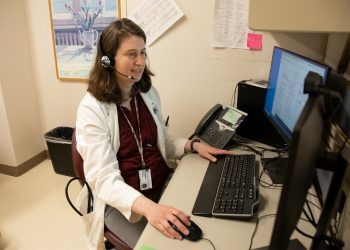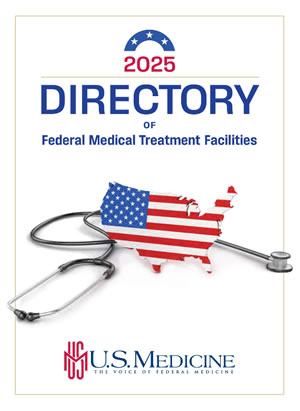
Daphne Friedman, MD, a staff physician and expert in blood cancers at the Durham VA Medical Center, delivers teleoncology and said she has seen improvements in her patients’ care. Photo from July 16,2021, VAntage Point blog
ANN ARBOR, MI — Approximately 50,000 U.S. military veterans are diagnosed with cancer annually, representing 3% of all cancers across the nation. These patients are a particularly vulnerable population during the pandemic, as a cancer diagnosis significantly increases risk of severe illness from COVID-19.
To help minimize the risk of transmitting SARS-CoV-2, the virus that causes COVID-19, VHA providers, as with those in nonfederal healthcare systems, changed the way they delivered healthcare during the pandemic. Adoption of telehealth became more widespread; one analysis found that the use of telehealth has increased 38-fold since the period before the pandemic.1
With the rapid shift to telemedicine, a new study analyzed how U.S. veterans with cancer perceived this modality of care during the pandemic and what policies are needed to optimize teleoncology in the long term.2
“We wanted to assess veteran satisfaction to determine ways it can continue to be improved and provide those who have served our country excellent healthcare,” said the study’s first author Cindy Y. Jiang, M.D., internal medicine resident physician at Michigan Medicine.
The study, published in the Journal of Oncology Practice, focused on patients receiving care at the Ann Arbor VAMC, where the percentage of oncology visits completed using telehealth (including video visits, telephone encounters, secure messages and electronic consults) doubled from November-February 2019 to March-June 2020. The researchers surveyed 100 patients who received at least one teleoncology visit in March-June 2020 and conducted a follow-up survey of patients who received at least one additional teleoncology visit in August 2020-January 2021.
During the initial survey period, they found that 83% of respondents were satisfied with teleoncology visits. Ninety percent of those surveyed said that their providers answered their questions satisfactorily, 85% said that their providers had engaged them in their care, and 88% agreed that teleoncology had saved them time.
Many patients also stated that they preferred in-person visits, however. In fact, nearly half of respondents said that teleoncology visits were not as satisfying as seeing their doctor face to face. Less than a quarter of those surveyed agreed that their health had improved as a result of a teleoncology visit. The resurvey period yielded similar patterns of results.
“Teleoncology definitely has its own unique challenges and obstacles,” Jiang pointed out. One is the inability to conduct a full physical exam to detect subtle changes (such as appearance of new lymph nodes), pulmonary signs (such as development of an effusion) or evidence of airway obstruction.
“However, other markers obtained through history are helpful surrogates, and patients can take their own vital signs at home,” she said. She also noted that a video component can help with assessing certain physical attributes, such as frailty and gait disturbances, that may have an impact on decisions regarding chemotherapy.
During the initial survey period, the researchers found that, although an audiovisual component didn’t affect patients’ overall satisfaction with teleoncology, the inclusion of video did increase cancer patients’ perceived involvement in their care, their perceived ability to self-manage their health and needs, and how favorably they compared teleoncology visits to in-person visits.
The study authors also estimated the financial and environmental impacts of teleoncology visits, which do not require patients to drive to appointments. They found that the 560 teleoncology visits conducted between March and June 2020 saved a total 86,470 miles of travel, reducing patients’ carbon footprint by about 35.5 metric tons. Veterans with cancer also saved a cumulative $49,720 in out-of-pocket travel expenses.
Rural-Urban Disparities
The study authors noted, however, that, although teleoncology can expand healthcare capacity, improve access to care and save patients time and money, it may exacerbate rural-urban health disparities.
“In rural settings, there can be lack of infrastructure to provide the equipment or high-speed internet access needed for audiovisual visits,” said Jiang. “From our study, it seems the way to enhance patient experience with teleoncology is having an audiovisual component. Without video capability, rural patients may become dissatisfied with teleoncology care and less willing to participate in this modality.”
She added that providers need to continue working to optimize access to equipment and improve infrastructure to support teleoncology, such as by pairing veterans with social workers to help them obtain equipment and internet services or helping veterans access telehealth via community-based outpatient clinics, where a nurse could assist with the technology, record vital signs and arrange for testing to be done locally.
“Part of intelligent growth is to identify best practices in teleoncology to realize the modality’s promise—studies like this are the first steps,” said Garth Strohbehn, MD, a co-author of the study and assistant professor of hematology/oncology at Michigan Medicine and the LTC Charles Kettles VAMC in Ann Arbor. “We hope that this technology will allow for increasingly specialized providers to help direct patient-centered care for veterans in a variety of living situations, including those who live in rural areas. I’m really optimistic about the future of teleoncology in the VHA—and as a health system, we’re poised to be a leader.”
According to a VA blog published in July, the healthcare system’s National TeleOncology Program delivers screenings, diagnostics and treatment for medical oncology—including rehabilitation and palliative care. In 2019, over 3,000 veterans received access to high-quality cancer treatment through teleoncology, and that number increased dramatically during the pandemic.
Daphne Friedman, MD, a staff physician and expert in blood cancers at the Durham VA Medical Center, said she has seen improvements in her patients’ care after they started utilizing TeleOncology. “I enjoy providing care through TeleOncology because I’m helping people who otherwise don’t have access to subspecialty cancer care,” said Friedman, who was quoted in the blog. “I know I’m making a difference.”
VA patients can access TeleOncology two different ways: Either with an internet-connected device in their own home through VA Video Connect (VVC), or at a nearby VAMC using clinical video telehealth (CVT). As of 2021, there are six TeleOncology sites located around the country, with some type of CVT/VVC support—and dozens more being developed. The VA said that, to further improve access, VA’s partners at AT&T, T-Mobile, Tracfone and Verizon all support zero-rating data charges for all VVC sessions for veterans.
- McKinsey & Company, “Telehealth: A quarter-trillion-dollar post-COVID-19 reality?” https://www.mckinsey.com/industries/healthcare-systems-and-services/our-insights/telehealth-a-quarter-trillion-dollar-post-covid-19-reality
- Jiang, Cindy Y., Strohbehn, Garth W., Dedinsky, Rachel M., Raupp, Shelby M., Pannecouk, Brittany M., Yentz, Sarah E., Ramnat, Nithya. Teleoncology for Veterans: High Patient Satisfaction Coupled With Positive Financial and Environmental Impacts. Journal of Oncology Practice. Published September 2021. DOI: 10.1200/OP.21.00317.

